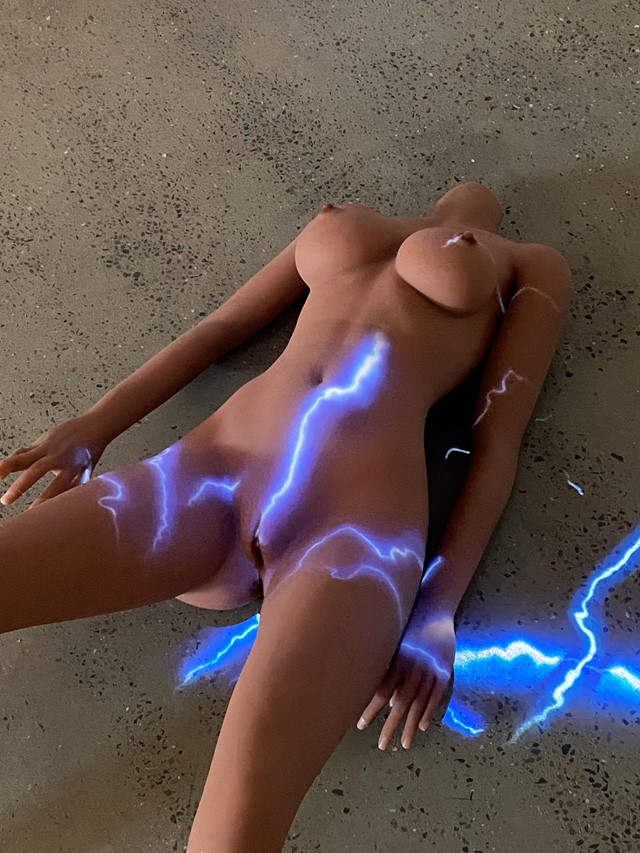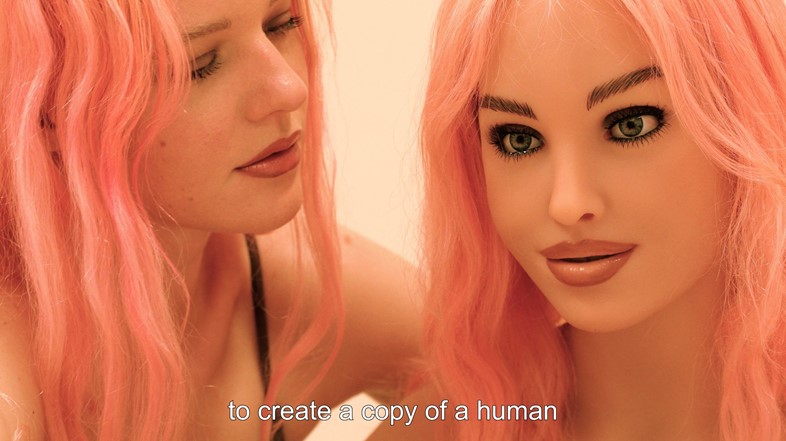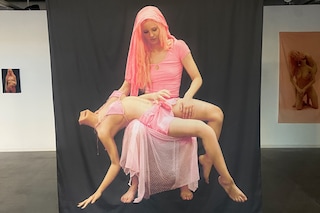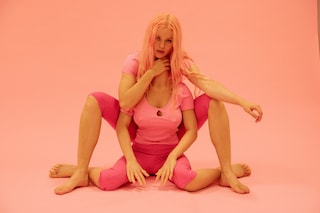The multidisciplinary artist gets up close and personal with Harmony, an AI sex doll, for her latest exhibition, A Doll’s House
This article is part of our Future of Sex season – a series of features investigating the future of sex, relationships, dating, sex work and sex worker rights; tech; taboos; and the next socio-political sexual frontiers.
“Machines have less problems,” Andy Warhol once famously remarked. “I’d like to be a machine. Wouldn’t you?” Back in 1963, when he expressed this wish, it probably seemed a fanciful desire; typical Warholian whimsy. Nearly 60 years later and the concept of life as an automaton seems less the stuff of science fiction and more like an inevitability. Multidisciplinary artist Arvida Byström argues that it is already a living reality. “I think we already are part cyborgs!” she tells Dazed. “We are living in a society that is so deeply intertwined with technology.”
As a digital native and part of the Tumblr generation, the Swedish-born multidisciplinary artist explores the points at which femininity and technology intersect. Using photography, film, and performance, she investigates the ideas such as disembodied feminine AI assistants like Siri, how Instagram censorship affects the female form, and a post-human future.
Some of her works include appearances from Harmony, the infamous AI sex doll made by Realdolls, as her ever-compliant collaborator. In a series of self-portraits, Byström poses with her eerily perfect companion dressed in identical outfits with matching hair and make-up. At times, they’re a cute pair of sexy BFFs, in other more disturbing and surreal images, Harmony is reduced to an exquisite torso, prone on the floor. Sometimes, she’s a radiantly smiling, decapitated head. At times your eye plays tricks and, for an uncanny moment, it’s not always easy to distinguish immediately between human and doll.
Among the portraits and a video installation, Byström’s latest exhibition, A Doll’s House at Galleri Format also features a performance piece called A Cybernetic Doll’s House, in which she will be interacting with Harmony and asking the sex doll questions provided by the audience.
Take a look through the gallery above for a glimpse of work from the show. Below, we speak to Arvida Byström about why she hopes humans will “accept” our inferiority, ways in which we‘re already living out Warhol’s fantasy of a mechanical existence, and her predictions for the post-humanism future.

Please could you introduce us to A Doll’s House?
Arvida Byström: The exhibition contains a number of photos as well as a video installation. The photographs are self-portraits I shot with the AI sex doll Harmony where we are styled similarly. The video is a 30-second-long film of Harmony pondering over post-humanism and if, through technology, humans can find a more humble way towards both technology and the environment by questioning the idea of humans being superior to other cognitive beings. There’ll also be a performance piece called A Cybernetic Doll’s House in which I ask Harmony questions people have sent to me.
I love the look of everything you make! How would you define your aesthetic and how did you cultivate it?
Arvida Byström: With photography, I wanted to explore a surrealistic aesthetic enhanced with some ambiguous and existential feelings. There is one photo where I lie behind the headless body of Harmony. If you look quickly it might appear to be my body and my head, but looking longer you will realise it is me hugging the doll and I am looking rather defeated. To me, this is a sort of poetic way of approaching post-humanism. A lot of philosophers from the tradition think that technologies are bad for humans, that just even an integrated technology like writing is tied to forgetting and that humans lose something human by doing it. The written language was believed to be invented in order to remember things that exceed the ways a human brain can remember things.
When uploading the show on Instagram I got into a very interesting discussion about whether chess computers are better than humans at chess. There seems to be some strange dispute about this in the chess community. What I found is that humans have started playing like computers! That is also a pretty concrete and interesting way to think about how we become technology... we create computers, technology brings something new to the table, and then we get inspired and copy technology’s ways of doing it. It’s a concept certain post-humans hate and others seem to welcome or at the least accept.
There is also a photo in the show where I and Harmony pose like a classical Pietà. To me, it is a poetic way of discussing who actually helps who when it comes to technology. Also, how we give birth to technology and then it surpasses us. Like Mary gave birth to Jesus, ha.
“Phones are definitely one of our cyborg features. We can detach them from our hands, but they are so often close to our bodies we could almost claim them as a body part” – Arvida Byström
What are the recurring themes of your work?
Arvida Byström: Femininity intertwined with technology seems to be what I keep on coming back to. Some of my work deals with the disembodied feminine AI assistants, more specifically iPhones’ Siri. Tech companies like to pretend technology doesn’t have a body, they sort of obscure it by using words like ‘cloud drives’ when they actually talk about outsourced hard drives. ‘Cloud’ sound like something non-physical that can’t damage our environment, but the truth is that cloud storage facilities are huge, they get really hot and they need a lot of electricity to run and systems to cool down.
So this got me to the other side of the spectrum – the AI sex doll. She is a very embodied AI, so to speak. The influencer girl is also like an ethereal, embodied through photos but also floating around all over the world, a kind of technological female. She is half-truth, half-fiction.
Why do these ideas continue to fascinate you?
Arvida Byström: Ha, great question. I guess I like material history that changes the way we think and the way we behave. I think a lot about how the technology of the tube for oil paint and the train were what facilitated the impressionists to change painting. It got cheaper to paint when you could keep it in a tube, you could more easily go out and paint in nature. Also, the train made it easier for the impressionists to get out there in the countryside, around other people. And the rise of the photograph pushed painters into an aesthetic that was less similar to photography.
To me, I see many similarities to how my career started. It was when the internet went into its second phase that was more visual and user-friendly. This pushed the development of digital cameras, making photography more easily accessible. Since I was a depressed teenager with social anxiety, reaching people with photography without having to leave my house.

Do you see us becoming more cyborg in the future?
Arvida Byström: I think we already are part cyborgs! We are living in a society that is so deeply intertwined with technology. Phones are definitely one of our cyborg features. We can detach them from our hands, but they are so often close to our bodies we could almost claim them as a body part.
And, as I mentioned before, the way we think is heavily influenced by small and big technologies. We’re allowing technology to create our thought patterns. That’s pretty cyborg-esque.
In what ways do you perceive machines to be superior to humans?
Arvida Byström: It is just a fact that machines are better at a lot of tasks than humans are. But humans are very well versed! We are great at learning a lot of different things even though we are pretty bad at most things compared to technology. We are not faster than cars and bicycles, but we can walk. There are computers that are great at mathematics, we can learn mathematics but most of the time computers are better than us.
But most of these computers and machines are very shit at anything other than their specific task. They are basically very limited whereas humans are great at learning new things.
I want our acceptance that machines are better than us to be an inspiring and soul-searching thing. What do humans actually want to do with this short time we are on Earth? Maybe we can find a way to work less and spend more time connecting with humans, animals, and nature, and interact with machines in meaningful ways.

As we become increasingly isolated and disembodied (working from home, social media etcetera), how do you feel we might be more likely to form even stronger attachments to machines?
Arvida Byström: I think we need to remember that everything is embodied. We have disembodied representations of ourselves online – even though these always need to be accessed through technology – and my fear is that governments and companies are going to let us only experience our lives through screens because that would be cheaper, more profitable and safer for them somehow.
I think humans, as the animals we are, will always need physical stimulation in the form of being close to other humans, connecting with animals, being in nature, doing sports, dancing and a lot of other things. Technology should enhance our lives, not rob us of the beauty of it.
In what ways do you envision sex and technology interesting in the future?
Arvida Byström: I think we are already doing a lot of it. Sexts, nudes, sex toys… all those things are ancient, but probably more common now. Of course, things like sex dolls and VR sex might happen and I am open to that. But I think it will never be a substitute for actually being close to another human and will be used most efficiently when it is letting people that are insecure in one way or another gaining confidence to dare to connect with others.
Arvida Byström’s A Doll’s House is at Galleri Format until September 11, 2022.










